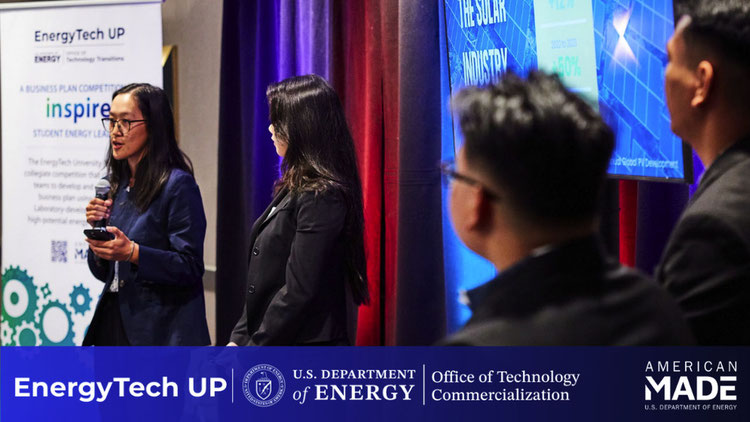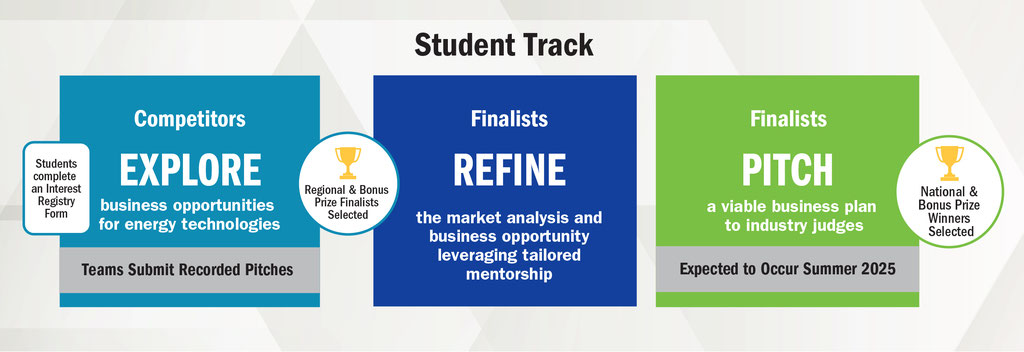Congratulations EnergyTech UP 2025 Winners!
The U.S. Department of Energy’s (DOE’s) Office of Technology Commercialization (OTC) announced winners of the EnergyTech UP 2025 National Pitch Event at Colorado School of Mines in Golden, Colorado.
At the event, prize finalists—multidisciplinary teams of post-secondary students from universities across the U.S.—pitched their innovative business plans to bring a DOE National Laboratory-developed or other high-potential energy technology to market.
For the 2025 round of the prize, winners were chosen from a large group of teams, representing dozens of schools and regions across the country. Finalist teams competed for the top three spots in the National Competition, as well as relevant Technology Bonus Prizes.
“This competition is an exciting sneak peek into the next generation of energy entrepreneurs,” said DOE Chief Commercialization Officer and Director of OTC, Anthony Pugliese. “Each team’s thoughtful and creative approach to their business plans showcases the power of young minds entering energy spaces across geothermal, grid, electricity delivery infrastructure, and more.”

The national winners, chosen from among the finalists named earlier this month, were awarded cash prizes as follows:
- First Place, awarded $50,000: Team Seal the Deal from Georgia Southern University. This team presented a novel seal design for supercritical carbon dioxide turbomachinery, addressing a critical bottleneck in next-generation nuclear and microreactor technologies.
- Second Place, awarded $35,000: Team AlchemII from University of Tennessee, Knoxville, who presented their business plan on a combination of pyrolysis and electrolysis techniques to efficiently produce hydrogen and graphite in one pot.
- Third Place, awarded $25,000: Team Nanoborne from University of Texas at Austin, who presented a nanoparticle-surfactant technology designed to improve the control of subsurface fluid flow.
In addition, 11 teams took home $20,000 cash bonus prizes sponsored by eight DOE program offices in the following categories:
Office of Technology Commercialization Undergraduate-Only Bonus Prize
- Team Bay State Energy from Boston University for their business plan on a cost-effective fission power system that relies solely on thermoelectric generators for energy conversion, potentially decreasing costs and improving reliability.
Office of Technology Commercialization National Lab IP Licensing Bonus Prize
- Team Stanford Maestro from Stanford University for their business plan on a software application based on an innovative GOOML framework from the National Renewable Energy Laboratory (NREL), designed to deliver agentic optimization for geothermal operations.
Arctic Energy Office Bonus Prize
- Team Graystone from University of Alaska Fairbanks for their business plan on utilization of carbon dioxide in its supercritical state (where it behaves as both a liquid and a gas) allowing it to penetrate solids and dissolve target materials with very high efficiency.
Geothermal Technologies Office Bonus Prize
- Team GasS Station from Duke University for their business plan on driving adoption of Geothermal Energy Hubs that can power co-located data centers.
Office of Nuclear Energy Bonus Prize
- Team Seal the Deal from Georgia Southern University for their business plan on a novel seal design for supercritical carbon dioxide turbomachinery, addressing a critical bottleneck in next-generation nuclear and microreactor technologies.
Office of Electricity Grid-Enhancing Technologies (GETs) Bonus Prize
- Team Project Solstice from CornellTech for their business plan on a unified data platform with a no-code interface that standardizes fragmented information from grid operators and utilities, providing interconnection risk modeling, feasibility assessments, and predictive analytics for data center site selection.
Office of Electricity Grid-Scale Power Electronics (PE) Bonus Prize
- Team Powerbox from University of Illinois, Urbana-Champaign for their business plan focused on a scalable, modular power integration device designed to provide 100% electrical uptime for industrial facilities by stabilizing unreliable grids and seamlessly integrating solar power with energy storage.
Office of Electricity Long-Duration Energy Storage (LDES) Bonus Prize
- Team SoHara from University of Alabama for their business plan on a technology that provides fast and accurate State-of-Health estimation and failure prediction for electrochemical batteries retired from electric vehicles for second use in other applications.
Solar Energy Technologies Office Bonus Prize
- Team IdealPV from Harvey Mudd College for their business plan on a solar technology that prevents hotspots by continuously monitoring dynamic conductance and intelligently adjusting current in milliseconds, preventing reverse bias before it starts.
Hydrogen and Fuel Cell Technologies Office Bonus Prize
- Team AlchemII from University of Tennessee, Knoxville for their business plan focused on combination of pyrolysis and electrolysis techniques to efficiently produce hydrogen and graphite in one pot.
Water Power Technologies Office Bonus Prize
- Team Pittsburgh Coastal Energy from University of Pittsburgh for their business plan for an onboard wave energy converter for charging underwater vehicle batteries at sea.
Thank you to everyone who applied and competed in EnergyTech UP 2025!




